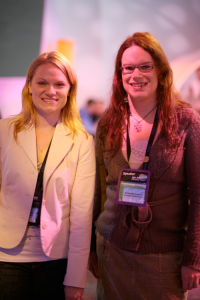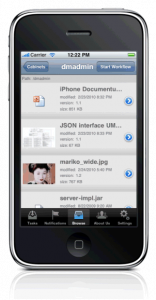We have got a written reaction to Mark Lewis’ keynote held at EMC World 2010 in Boston. I both feel and have the passion around Enterprise Content Management and it is great that Laurence Hart spent so much time and effort on talking to people to craft this post. Someone need to say things even if they are not always easy to hear. So I will try to not repeat what he said in this blog post but rather try to provide my perspective which comes from what I have learned about Information and Knowledge Management over the past years. ECM and Documentum is a very critical component to move that IKM vision from the Powerpoint stage into reality. In our case an experimentation platform that allows to put our ideas to improve the “business” of staff work in a large military HQ into something people can try, learn and be inspired from. Also, this turned out to be a long blog post which calls for an summary on top:
The Executive Summary (or message to EMC IIG) of this blog post:
- Good name change but make sure You live up to your name.
- A greater degree of agility is very much needed but do not simplify the platform so much that implementing an ECM-strategy is impossible.
- Case Management is not the umbrella term, it is just one of many solutions on top of Documentum xCP
- The whole web has gone Social Media and Rich Media. The Enterprise is next. Develop what You have and stay relevant in the 2010-ies!
- Be more precise when it comes to the term “collaboration”. There is a whole spectrum to support here.
- Be more bold and tell people that Documentum offers an unique architectural approach to informtion management – stop comparing clients.
- Tell people that enabling Rich Media, Case Management, E 2.0 and (Team) Collaboration on one platform is both important and possible.
- I am repeating myself here: You want to sell storage, right? Make sure Video Management is really good in Documentum!
The name change
Before I start I just need to reflect on the name change from Content Management and Archiving into Information Intelligence Group (IIG). I agree with Pie…the had to be changed to make it more relevant in 2010 and a focus on information (as in information management which is more than storage ILM) is the right way to go. The intelligence part of it is of course a bit fun because of my own profession but still it implies doing smart things with information and that should include everything from building context with Enterprise 2.0 features to advanced Content and Information Analytics. You have the repository to store all of that – now make sure you continue to invest in analytics engine to generate structure and visualisation toolkit to make use of all the metadata and audit trails. Maybe do something with TIBCO Spotfire.
Documentum xCP – lowering the threshold and creating a more agile platform
Great. Documentum needs to be easier to deploy, configure and monitored. Needed to get know customers on board easier and make existing ones be able to do smarter things with it in less time. However, it is easy to fall into the trap of simplifying things to much here. To me there is nothing simple around implementing Enterprise Content Management (ECM) as a concept and as a method in an organization. One major problem with Sharepoint and other solutions is that they are way to easy to install so people actually are fooled into skipping the THINKING part of implementing ECM and think it is just “next-next-finish”. All ECM-systems needs to be configured and adapted to fit the business needs of the organisation. Without that they will fail. xCP can offer a way to do that vital configuration (preceeded by THINKING) a lot more easier and also more often. We often stress how it is important to have the technical configuration move as close to any changes in Standard Operating Procedures (SOP) as possible. If Generals want to change the way they work and the software does not support it they will move away from using the software. Agility is the key.
In our vision the datamodel needs to be much more agile. Value lists need to updated often – sometimes based on ad hoc folksonomy tagging. Monitoring of the use of metadata and tags will drive that. Attributes or even object types need to be updated more often. Content need to be ingested quickly while providing structure later on (think XML Store with new schemas here). xCP is therefore a welcome thing but make sure it does not compromise the core of what makes Documentum unique today.
The whole Case Management thing
Probably the thing that most of us reacted against in the Mark Lewis Keynote was the notion that ECM-people in reality just have done Case Management all the time. I recently spend some time reflecting on that in another blog post here called “Can BPM meet Enterprise 2.0 over Adaptive Case Management?“. There is clearly a continuum here between supporting very formal process flows and very ad-hoc Knowledge Worker-style work. They clearly seem different and while they likely meet over Adaptive Case Management but to me it makes no sense to have that term cover the whole spectrum – even for EMC Marketing 🙂
I immediately saw that Public Sector Investigative work is often used as an example of Case Management. Case Management in especially done by law enforcement agencies is fundamentally different from work done by Intelligence Agencies because in Case-based Police investigations there is usually some legal requirement to NOT share information between cases unless authorised by managers. This is of not the case (!) for all Case Management applications but from a cultural perspective it is important that Case Management-work by the Police is not a line of business that should be used as an example of information sharing. It is even so that the underlying concept actually is at ends with any concept of unified enterprise content management strategy where information should be shared. That is why workgroup-oriented tools such as i2 Analyst’s Workstation have become so popular there.
The point here is that it is important to not disable sharing in the architectural level because again it is what constitutes a good ECM-system that content can be managed in a unified way. Don’t be fooled by requirements for that – use the powerful security model to make it possible. Then Law Enforcement Agencies can use it as well. However, there must be more to ECM than Case Management – as Word of Pie suggests it is just ONE of many solutions on top of the Documentum xCP platform. A platform which is agile enough to quickly build advanced solutions for ECM on top.
Collaboration vs Sharing and E.20
So, Collaboration is used everywhere now but the real meaning with it actually varies a bit. First there are two kind of collaboration modes:
- Synchronous (real-time)
- Asynchronous (non-real time – “leave info and pick up later)
Obviously neither Documentum nor Sharepoint is in real-time part of the business. For that you will need Lotus Sametime, Office Communications Server, Adobe Connect Pro or similar products. However, Google Wave provides a bit of confusion here since it integrates instant messaging and collaborative document editing/writing.
However, I am bit bothered by the casual notion of anything as a collaboration tool like Sharepoint and for that sake eRoom is getting. To further break this down I believe there is a directness factor in collaboration. Team collaboration has a lot of directness where you collaborate along a given task with collegues. That is not the same as many of the Social Media/Enterprise 2.0 features which does not have a clear recipient of the thing you are sharing. And sharing is the key since you basically are providing a piece of information in case anyone wants/needs it. That is fundamentally different from sending an email to project members or uploading the latest revision to the project’s space. Andrew McAffe has written about this concept and uses the concept of a bullseye representing strong and weak ties to illustrate this effect.
My point is that it is important that tools for team collaborations from an information architecture standpoint can become part of the more weaker indirect sharing concept. That is the vehicle to utilze the Enterprise 2.0 effect in a large enterprise. Otherwise we have just created another set of stove-pipes or bubbles of information that is restricted to team members. I am not saying that all information should be this transparent but I will argue that based on a “responsibility to provide”-concept (see US Intel Community Information Sharing Policy) restricting that sharing of information should be exception – not the norm.
Sure as Word of Pie points out in his article “CenterStage, the Latest ex-Collaboration Tool from EMC” there are definitely things missing from the current Centerstage release compared to both Sharepoint and EMC’s old tool eRoom. However, as Andrew Goodale points out in the comments I also think it is a bit unfair because both eRoom and at least previous versions of Sharepoint (which many are using) actually lacks all these important social media features that serves to lower the threshold and increase participation by users. They also provide critical new context around the information objects that was not available before in DAM, WebTop or Taskspace. Centerstage also provides a way to consume them in terms of activity streams, RSS-feeds and faceted search. Remember that Centerstage is the only way to surface those facets from Documentum Search Server today.
So, I am also a bit disappointed that things are missing in Centerstage that should be there and I also really want to stress the importance of putting resources into that development. Those features in there are critical for implementing all serious implementations of an ECM-strategy and the power of Documentum is that they all sits in the same repository architecture with a service layer to access them. Maybe partner with Socialcast to provide a best practice implementation to support a more extensive profile page and microblogging. Choose a partner for Instant Messaging in order to connect the real-time part of collaboration into the platform. Again, use your experience from records management and retention policies to make those real-time collaboration activities saved and managed in the repository.
Be bold enough to say you are an Sharepoint alternative – but for the right reasons
I’m not an IT-person, I come into this business with a vision change the way a military HQ handles information so I see Enterprise Content Management more as a concept than a technology platform. However, when I have tried to execute our vision it becomes very clear that there is a difference between technology vendors and I like to think that difference comes from internal culture, experience, and vision of the company. It is the “why” behind why the platform looks like it does and has the features it has. So as long you are not building everything from scratch for yourself it actually matters a lot which company you chose to deliver the platform to make your ECM vision happen. That means that there IS a difference between Documentum and Sharepoint in the way the platform works and we need to be able to talk about that. However, what I see now is that most people focus on the client side of it and try to embrace it is a popular collaboration tool. Note that I say tool – not platform. All those focuses on the client side of it where the simplified requirement is basically a need for a digital space to share some documents in. However, the differentiator is not whether Centerstage or Sharepoint meets that requirement – both do. The differentiator is whether you have a conceptual vision on how to manage the sum of all information that an organization have and to what degree those concepts can be implemented in technology. That is where the Documentum platform is different from other vendors and why it is different from Sharepoint. Sharepoint is sometimes a little bit to easy to get started with which unfortunately means there is no ECM-strategy behind the implementation and when the organisation have thousands of Sharepoint sites (silos) after a year or so that is when that choice of platform really starts to differ.
This week at EMC World has been a great one as usual and there is no shortage of brilliant technical skills and development of features in the platform. What I guess bothers me and some other passionate ECM/Documentum-people is the message coming out from the executive level at IIG. In the end, that is where the strategic resource decision are made and where the marketing message being constructed. I think now there is a lot more to do on the vision and marketing level than actually needs to be done on the platform itself. The hard part seem to be proud of what the platform is today, realize it’s potential to remain the most capable and advanced on the market and use that to stay relevant in many applications of ECM – not just Case Management.
Rich Media – A lot of content to manage and storage to sell
One of the strong points of Documentum is that it can manage ALL kind of content in a good way and that includes of course rich media assets such as photos, videos and audio files. Don’t look upon this as some kind of specialised market only needed by traditional “creative” markets. This is something everybody needs now. All companiens (and military units for that sake) have an abundance of digital still and video cameras where a massive amount of content needs to be managed just as all the rest of the content. There is a need for platform technologies that actually “understands” that content and can extract metadata from it so that this content can be navigated and found easily. It is also important to assist users in repurposing this content so it can be displayed easily without consuming all bandwith and also easily be included in presentations and other documents. This is also very much relevant from a training and learning perspective where screencams and recorded presentations has so much potential. It does not have to be a full Learning Management System but at least an easy way to provide it. Maybe have a look at your dear friend Cisco and their Show and Share application. Oh, it is marketed as a Social Video System – the connections to Centerstage (and not just MediaWorkspace) is a bit too obvious. Make sure you can provide Flickr and Youtube for the Enterprise real soon. People will love it. Again, on one very capable platform.
Media Workspace is a really cool application now. Even if it does not have all the features of DAM yet (either) it is such a sexy interface on Documentum. The new capabilites of handling presentations and video are just great. Be sure to look more at Apple iPhoto and learn how to leverage (and create) metadata to support management of content based on locations, people and events. A piece of cake on top of a Documentum repository. Now it is a bit stuck in the Cabinet/Folder hierarchy as the main browsing interface.
Summary
I agree with Word of Pie that there is a lack of vision – an engaging one that we all can buy into and sell back home to our management. In my project we seem to have such a vision and for us Documentum is a key part of that. I just hoped that EMC IIG would share that to a greater degree. From our responses back home in Sweden and here at EMC World people seem to both want and like it (have a look at my EMC World presentation and see what you think). We can do seriously cool and fun stuff that will make management of content so much more efficient which should be of critical importance for every organisation today. At least in the military one thing is for sure and that is that we won’t get more people. We really have to work smarter and that is what a vision like this will provide a roadmap towards.
So be proud of what you do best EMC IIG and make sure to deliver INTEGRATED solutions on top of that. For those who care that will mean a world of difference in the long run and will gather looks of envy for those who did not get it.
![Reblog this post [with Zemanta]](https://img.zemanta.com/reblog_e.png?x-id=09e90eca-a116-4f7f-9a99-dbc531ad2573)


